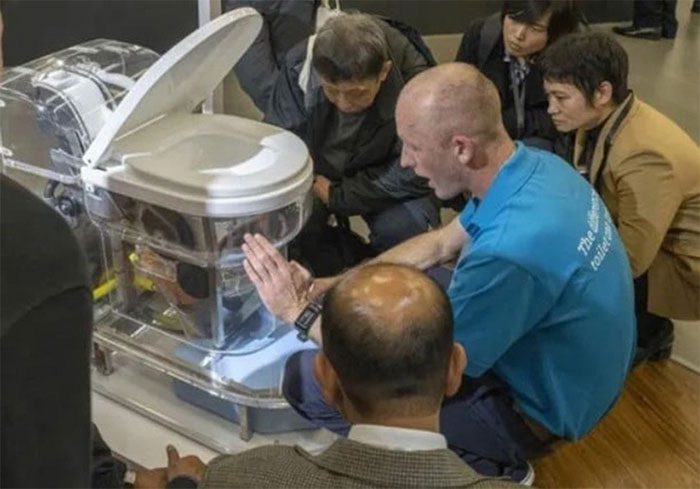Mirrors and toilets that can detect diseases early, floor materials capable of measuring users’ fall risks—these are innovations that may soon appear in luxury bathrooms of the future.
According to many design and technology experts, driven by health concerns, technologically integrated bathrooms will become increasingly popular in high-end homes in the United States over the next few decades, as noted by the Wall Street Journal in a recent article on this trend.
Toilets that Detect Health Issues
Thomas Serval, co-founder and CEO of the French healthcare technology company Baracoda, stated that many leading hospitals, hotels, and several ultra-luxury villas in China have already adopted smart toilet technology.

Toilets are being improved to meet more human needs – (Photo: The New York Times)
According to Steve Scheer, president of Brondell, a household technology company in the U.S., toilets with these advancements can alleviate the burden on the healthcare system while also allowing seniors to remain safely at home.
In the future, many homeowners will seek multifunctional toilets that can self-clean or analyze urine.
Vik Kashyap, CEO of Toi Labs (a company specializing in smart toilets in the U.S.), mentioned that based on chemical analysis of waste, toilets can detect various health issues such as urinary tract infections and kidney problems.
Kashyap added that Toi Labs’ technology is already being used in the restrooms of several elder care facilities.
Toi Labs toilets are equipped with a downward-facing camera that analyzes waste using artificial intelligence (AI). These facilities pay Toi Labs between $45 and $65 per month (approximately 1.1 to 1.6 million VND) for each toilet, which includes a daily report.
Toi Labs plans to integrate electronic nose technology to identify odors that signal diseases within waste.
They are also developing toilets that use various types of light projected onto the skin to measure body temperature, heart rate, and blood oxygen levels. Toi Labs asserts that their sensors do not capture images of body parts, and the collected data will remain anonymous.
Many manufacturers of smart toilets are also developing technologies using ultraviolet light and cleaning agents for self-cleaning capabilities. Each self-cleaning toilet can start at around $500, or significantly higher. For instance, Kohler’s Numi 2.0 toilet, which features sterilization, heated seats, and a personal bidet function, can cost up to $8,600.
According to Bill Strang, head of Toto USA, a manufacturer of self-cleaning toilets in the U.S., reports indicate that the demand for this premium fixture has been steadily increasing in the U.S. over the past five years.
Reducing Water Waste
According to the U.S. Environmental Protection Agency (EPA), water usage in toilets is extremely wasteful, accounting for nearly one-third of the total water used in each household.
In many parts of the world, flush toilets face challenges due to climate change, leading to severe droughts or floods that clog drainage systems or cause septic tanks to overflow, as reported by CNN.
In disaster-stricken or water-scarce areas, the demand for clean, waterless toilets is becoming increasingly urgent.
Alternative solutions for waste management can provide numerous benefits, such as retaining waste that can be converted into heat, electricity, or organic fertilizers.
“Waste is not just waste; it is a resource.” Finnish artist and architect Arja Renell shared, introducing a circular approach: the “dry” toilet. According to Renell, “Huussi” in Finnish refers to a type of dry toilet that separates urine from feces and is designed to be ventilated to avoid odor.
In Finland, dry toilets are particularly popular in rural homes. After “doing their business,” users cover the waste in the holding tank with peat or sawdust.
Once the tank is full, they transfer the feces to a larger anaerobic container for several months for microbial decomposition. The residue after decomposition is a material rich in nitrogen and phosphorus, which can be used as a natural fertilizer instead of synthetic fertilizers that emit greenhouse gases.
Another type of waterless toilet is the incinerating toilet. This fixture has existed for several decades, but until recently, available models have been quite large, bulky, and noisy.
However, technological advancements may make them more popular. The price for these toilets ranges from $2,500 to $4,000 depending on the brand, not including operational energy costs.
“The mirror hangs on the wall”CEO Serval of Baracoda mentioned that the company owns CareOS—a smart mirror operating system expected to connect users with medical professionals upon detecting health abnormalities. Smart mirrors integrated with AI can also provide personalized skincare recommendations, while augmented reality technology in the mirror will guide users through “facial yoga” techniques or meditation. The Canadian medical device company NuraLogix recently introduced a desk mirror equipped with a camera that tracks blood flow on the user’s face, determining blood pressure and predicting risks such as heart attacks, strokes, and hypertension. |


















































